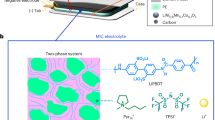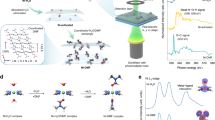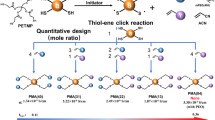Abstract
To utilize the fascinating properties of clays, including their large surface areas, many dissociable cations in the interlayers and low-dimensional structure, we focused on controlling the orientation of clay layers in ion-conductive polymer electrolytes. The application of a strong magnetic field is one of the effective methods used to control the orientation of clay layers and to improve the ionic conductivity of the clay composites. In this study, two different composite films were obtained using different orientations of the magnetic field: perpendicular (M⊥) and parallel (M//) to the film surface. From two-dimensional wide-angle X-ray diffraction measurements, the montmorillonite (MMT) layers preferentially oriented along the direction of the magnetic fields in the composites. There were substantial correlations between the conductivity and the ratio of MMT layers oriented along the direction of the conductivity measurement. The lowest conductivity was observed in the M// composite, whereas the M⊥ composite showed very good conductivity. The value was higher than that of the original electrolytes (PMEO10LiClO4) at 30 °C. These results clearly suggest that the orientation direction of the MMT layers toward the direction parallel to the conductivity measurement causes an improvement in the conductivity of the composites. In particular, the conductivity value of the M⊥ composite with 5 wt% Li–MMT was 1.2 × 10−5 S cm−1 at 30 °C, which was more than six times higher than the original electrolyte.
Similar content being viewed by others
Log in or create a free account to read this content
Gain free access to this article, as well as selected content from this journal and more on nature.com
or
References
Armand, M. B., Chagagno, J. M. & Duclot, M. T. In Fast Ion Transport in Solids (eds Vashishta P., Mumdy J. N., Shennoy G. K., 131 (Amsterdam, North-Holland, 1979).
Tarascon, J. M. & Armand, M. Issues and challenges facing rechargeable lithium batteries. Nature 414, 359–367 (2001).
Ratner, M. A. & Shriver, D. F. Ion-transport in solvent-free polymers. Chem. Rev. 88, 109–124 (1988).
Bruce, P. G. Solid State Electrochemistry, (Cambridge University Press, Cambridge, 1995).
Croce, F., Scrosati, B. & Mariotto, G. Electrochemical and spectroscopic study of the transport-properties of composite polymer electrolytes. Chem. Mater. 4, 1134–1136 (1992).
Croce, F., Appetecchi, G. B., Persi, L. & Scrosati, B. Nanocomposite polymer electrolytes for lithium batteries. Nature 394, 456–458 (1998).
Marcinek, M., Bac, A., Lipka, P., Zalewska, A., Zukowska, G., Borkowska, R. & Wieczorek, W. Effect of filler surface group on ionic interactions in PEG-LiClO4-Al2O3 composite polyether electrolytes. J. Phys. Chem. B 104, 11088–11093 (2000).
Tominaga, Y., Igawa, S., Asai, S. & Sumita, M. Ion-conductive properties of mesoporous silica-filled composite polymer electrolytes. Electrochim. Acta 50, 3949–3954 (2005).
Aranda, P. & Ruizhitzky, E. Poly(ethylene oxide)-silicate intercalation materials. Chem. Mater. 4, 1395–1403 (1992).
Wu, J. H. & Lerner, M. M. Structural, thermal, and electrical characterization of layered nanocomposites derived from Na-montmorillonite and polyethers. Chem. Mater. 5, 835–838 (1993).
Giannelis, E. P. Polymer layered silicate nanocomposites. Advan. Mater. 8, 29–35 (1996).
Kuppa, V. & Manias, E. Computer simulation of PEO/layered-silicate nanocomposites: 2. Lithium dynamics in PEO/Li+ montmorillonite intercalates. Chem. Mater. 14, 2171–2175 (2002).
Vaia, R. A., Sauer, B. B., Tse, O. K. & Giannelis, E. P. Relaxations of confined chains in polymer nanocomposites: glass transition properties of poly(ethylene oxide) intercalated in montmorillonite. J. Polym. Sci. B-Polym. Phys. 35, 59–67 (1997).
Anastasiadis, S. H., Karatasos, K., Vlachos, G., Manias, E. & Giannelis, E. P. Nanoscopic-confinement effects on local dynamics. Phys. Rev. Lett. 84, 915–918 (2000).
Elmahdy, M. M., Chrissopoulou, K., Afratis, A., Floudas, G. & Anastasiadis, S. H. Effect of confinement on polymer segmental motion and ion mobility in PEO/layered silicate nanocomposites. Macromolecules 39, 5170–5173 (2006).
Kitajima, S. & Tominaga, Y. Enhanced cationic conduction in a polyether/clay composite electrolyte treated with supercritical CO2 . Macromolecules 42, 5422–5424 (2009).
Kitajima, S. & Tominaga, Y. Improvement in dispersion and ionic conductivity of polyether/freeze-dried clay composites using supercritical carbon dioxide as treatment medium. Ionics 18, 845–851 (2012).
Hutchison, J. C., Bissessur, R. & Shriver, D. F. Conductivity anisotropy of polyphosphazene-montmorillonite composite electrolytes. Chem. Mater. 8, 1597–1599 (1996).
Sun, T., Chen, F., Dong, X., Zhou, Y., Wang, D. & Han, C. C. Shear-induced orientation in the crystallization of an isotactic polypropylene nanocomposite. Polymer (Guildf) 50, 2465–2471 (2009).
Kim, D. H., Park, J. U., Ahn, K. H. & Lee, S. J. Electrically activated poly(propylene)/clay nanocomposites. Macromol. Rapid Commun. 24, 388–391 (2003).
Park, J. U., Choi, Y. S., Cho, K. S., Kim, D. H., Ahn, K. H. & Lee, S. J. Time-electric field superposition in electrically activated polypropylene/layered silicate nanocomposites. Polymer (Guildf) 47, 5145–5153 (2006).
Uyeda, C., Takeuchi, T., Yamagishi, A. & Date, M. Diamagnetic orientation of clay mineral grains. J. Phys. Soc. Jpn 60, 3234–3237 (1991).
Uyeda, C., Ohtawa, K., Okita, K. & Uyeda, N. Diamagnetic anisotropy derived from single chemical bonds in the silicate tetrahedral networks. J. Phys. Soc. Jpn 70, 889–892 (2001).
Uyeda, C., Tanaka, K., Takashima, R. & Sakakibara, M. Characteristics of paramagnetic and diamagnetic anisotropy which induce magnetic alignment of micron-sized non-ferromagnetic particles. Mater. Trans. 44, 2594–2598 (2003).
Kimura, T., Uemura, T., Takagi, S. & Inoue, H. Magnetic alignment of rhodamine B intercalated in synthetic mica. Macromol. Symp. 242, 120–125 (2006).
Ebina, T., Minja, R. J. A., Nagase, A. T., Onodera, Y. & Chatterjee, A. Correlation of hydraulic conductivity of clay-sand compacted specimens with clay properties. Appl. Clay Sci. 26, 3–12 (2004).
Takahashi, T., Ohkubo, T. & Ikeda, Y. Montmorillonite alignment induced by magnetic field: evidence based on the diffusion anisotropy of water molecules. J. Colloid Interface Sci. 299, 196–203 (2006).
Dadmun, M. D. & Han, C. C. A neutron-scattering study of the orientation of a liquid-crystalline polymer by shear-flow. Macromolecules 27, 7522–7532 (1994).
Malwitz, M. M., Butler, P. D., Porcar, L., Angelette, D. P. & Schmidt, G. Orientation and relaxation of polymer-clay solutions studied by rheology and small-angle neutron scattering. J. Polym. Sci. B-Polym. Phys. 42, 3102–3112 (2004).
Tominaga, Y., Izumi, Y., Kwak, G. H., Asai, S. & Sumita, M. Effect of supercritical carbon dioxide processing on ionic association and conduction in a crystalline poly(ethylene oxide) - LiCF3SO3 complex. Macromolecules 36, 8766–8772 (2003).
Chen, H. W., Chiu, C. Y., Wu, H. D., Shen, I. W. & Chang, F. C. Solid-state electrolyte nanocomposites based on poly(ethylene oxide), poly(oxypropylene) diamine, mineral clay and lithium perchlorate. Polymer (Guildf) 43, 5011–5016 (2002).
Loyens, W., Maurer, F. H. J. & Jannasch, P. Melt-compounded salt-containing poly(ethylene oxide)/clay nanocomposites for polymer electrolyte membranes. Polymer (Guildf) 46, 7334–7345 (2005).
Ohtake, T., Ogasawara, M., Ito-Akita, K., Nishina, N., Ujiie, S., Ohno, H. & Kato, T. Liquid-crystalline complexes of mesogenic dimers containing oxyethylene moieties with LiCF3SO3: self-organized ion conductive materials. Chem. Mater. 12, 782–789 (2000).
Kishimoto, K., Suzawa, T., Yokota, T., Mukai, T., Ohno, H. & Kato, T. Nano-segregated polymeric film exhibiting high ionic conductivities. J. Am. Chem. Soc. 127, 15618–15623 (2005).
Majewski, P. W., Gopinadhan, M., Jang, W. S., Lutkenhaus, J. L. & Osuji, C. O. Anisotropic ionic conductivity in block copolymer membranes by magnetic field alignment. J. Am. Chem. Soc. 132, 17516–17522 (2010).
Acknowledgements
This work was financially supported by a Grant-in-Aid for Young Scientists (B) (No. 21750113) from the Ministry of Education, Culture, Sport, Science and Technology, Japan.
Author information
Authors and Affiliations
Corresponding author
Ethics declarations
Competing interests
The authors declare no conflict of interest.
Rights and permissions
About this article
Cite this article
Kitajima, S., Matsuda, M., Yamato, M. et al. Anisotropic ionic conduction in composite polymer electrolytes filled with clays oriented by a strong magnetic field. Polym J 45, 738–743 (2013). https://doi.org/10.1038/pj.2012.207
Received:
Revised:
Accepted:
Published:
Issue date:
DOI: https://doi.org/10.1038/pj.2012.207



